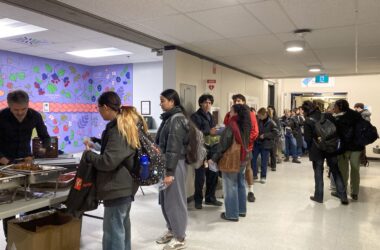McGill held its second annual interdisciplinary biotechnology symposium last Tuesday. The symposium, held at New Residence Hall, focused on bridging the gap between industry and academia. and included presentations by speakers from both fields, a student poster competition, and a networking session. The event was organized by the BioConnect 2011 Executive Committee, consisting of various McGill University graduate students.
“Our speakers will focus on bridging the gap to science and patents,” MichaÅ Bonar, Symposium Chair, said before the event. “McGill’s biotechnology program is an applied master’s program, so many depend on networking … [and] this is the first year we know we have real contacts [in the industry].”
Presentations brought a focus to the business side of research and the support resources students can find to make a connection between their graduate research and industry. Dr. Sathy Rajasekharan, Associate Director of the newly-established McGill Centre for Biomedical Innovation, spoke about the importance of seeking help when looking to take an idea to the industry.
“[The Centre] is looking at this from a very simple way. Our short-term goals are to align the various resources that are out there … The key is to make sure that the person that is interested has a route and a plan and it’s their choice to push that and if they need help, they will be given that help,” Rajasekharan said, in his presentation entitled “Engines of Innovation: Industry, Academia and Entrepreneurship.”
In light of the current economic situation, he told students, “The best thing you can do is try.”
Jesse Vincent-Herscovici, Director of Business Development at Mitacs, a non-profit organization that connects research to companies, also highlighted opportunities for graduate students, such as research grants offered by Mitacs. In his talk, “Maximizing the Impact of University-Industry Partnerships,” he emphasized that industry needs to show students “that Canada is the place to be.”
Other presentations included “Life Sciences in Quebec: An Investor’s Point of View,” “Key Business Trends in the Bio-Pharma Industry,” and “Intellectual Property Rights.”
New this year was a poster competition judged by several McGill professors.
“The posters were tremendous,” Dr. Tim Geary, a judge and professor from the parasitology department of McGill, said before presenting the prizes. The winning poster was “Cell State for Neural Progenitor Isolation,” by Sana Rathore. In total, 16 graduate student projects participated in the friendly competition. There were also booths of various sponsors of the event and representatives from companies and hospitals.
The event was well-attended and seemed to spark the interest of students and professional representatives.
“I got an idea of what’s available for students when they’re leaving academia … what’s available after university,” Micaela Das Gupta, a PhD student in neuroscience, said.
The networking session also gave student attendees the opportunity to create contacts in a variety of sectors and with other students. In the closing comments, Jonathan Madriaga, the Sponsorship Chair from the Executive Committee, expressed the desire to expand the symposium.
“We look to develop BioConnect into a larger event while keeping mutually beneficial relationships,” he said.






